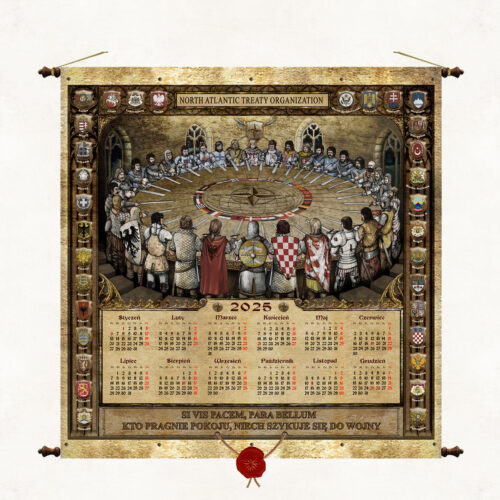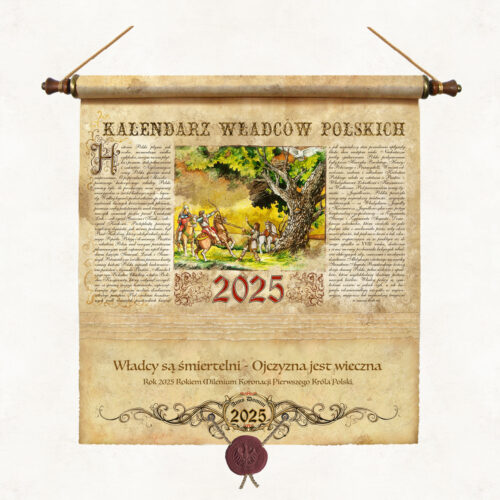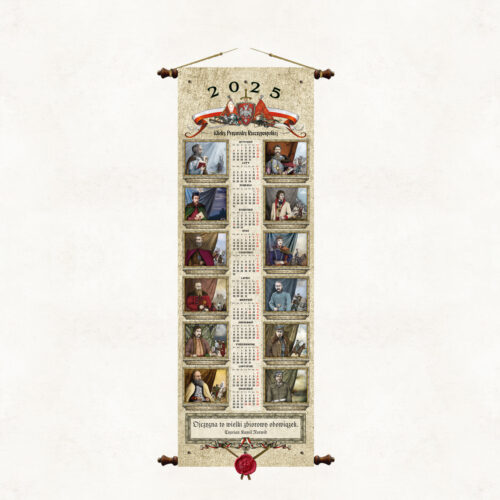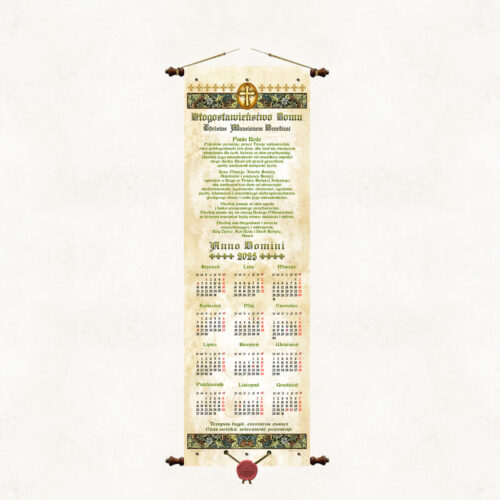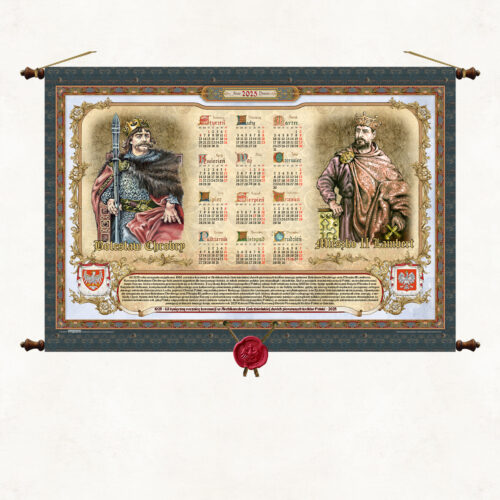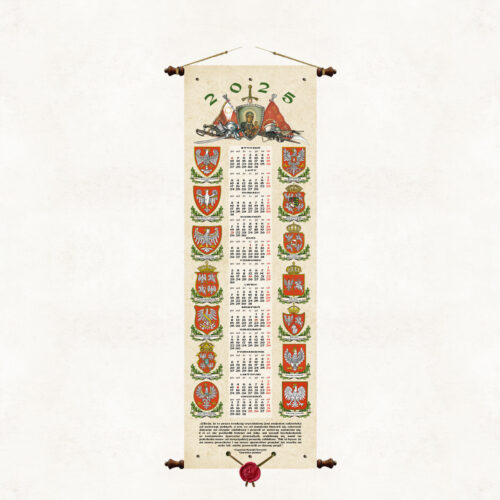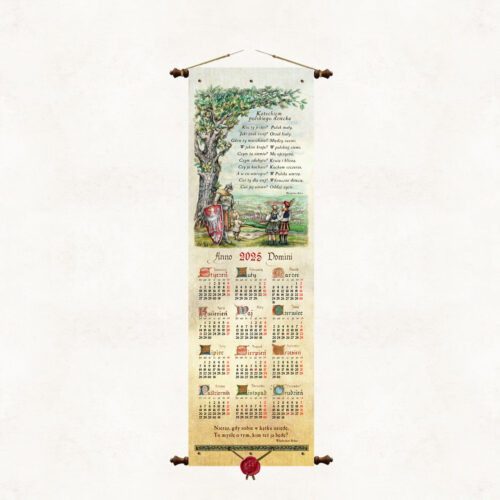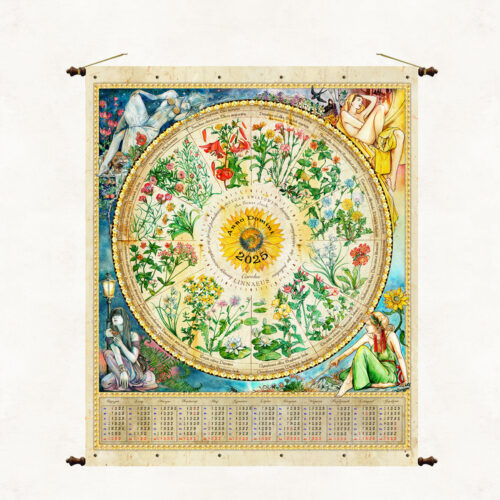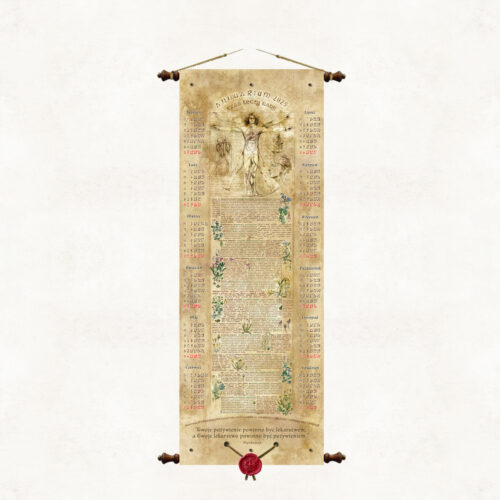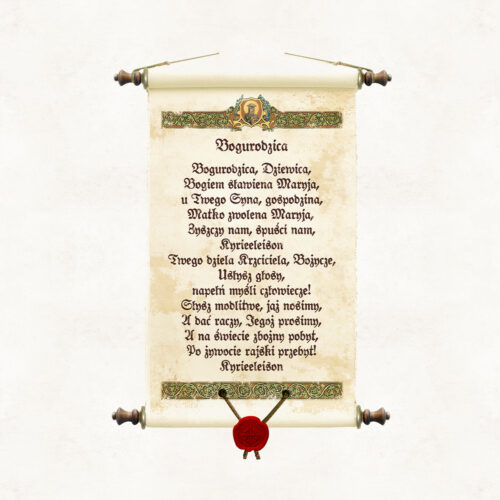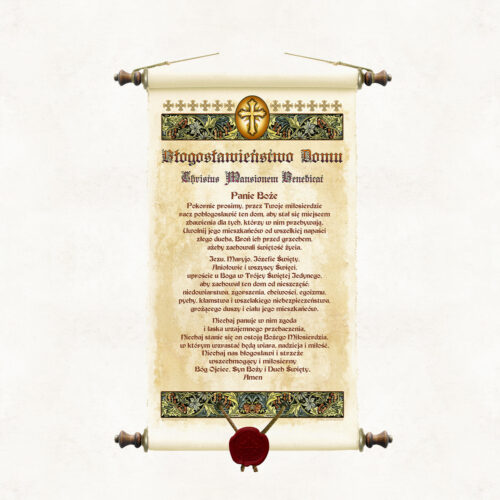-
A publication dedicated to soldiers and all defenders of freedom and peace gathered around the North Atlantic Treaty Organization (NATO). In an allegorical illustration referring to the Arthurian legend of the Knights of the Round Table, we have shown representatives of NATO member states stylized as knights. The motto of the calendar is a Latin proverb, paraphrased from the prologue to the work On the Art of War by Vegetius, a Roman historian from the 4th century AD Si vis pacem, para bellum – “If you want peace, prepare for war”. In the cartouches forming the frame of the image, we have placed the emblems of NATO countries.
-
The rulers are mortal - The homeland is eternal 14-page calendar of the Rulers of Poland – Millennium souvenir of the coronation of the first king of Poland, Bolesław Chrobry This is an exceptional publication, its form, content and the idea it serves make it deserve the title of a millennium souvenir in every respect. This great anniversary has become an opportunity for us to present the topic of Polish rulers in a comprehensive form in the form of a unique calendar – album. Following the drawings from the Collection of Polish Kings and Princes by Jan Matejko, we have created our own original collection of 48 colour portraits of Polish rulers, supplemented with figures that Master Matejko did not draw. Each month's page features images of four historical figures with short biographies. The year 2025 will mark the thousandth anniversary of the coronation in Gniezno of two Polish kings, Bolesław the Brave and his son Mieszko II Lambert. The coronation of the first Polish king, Bolesław the Brave, took place in the Gniezno cathedral most likely on Easter, which then fell on April 18. Two months later, Chrobry died and his son Mieszko II took over the inheritance. The coronation ceremony took place the same year on Christmas, also in Gniezno.
-
An original calendar with a beautiful prayer for the blessing of a house and its inhabitants, beginning with the Latin sentence Christus mansionem benedicat ("May Christ bless this house"). Receiving and giving a blessing is one of the most important aspects of the religious life of Christians. The prayer for a Blessing is words equipped with effective spiritual power, thanks to which an individual or a community feels strengthened and safe, free from fear and resistant to the influence of evil. A blessing is a gift from God, from whom all good comes, it is a tangible manifestation and confirmation of His life-giving presence in the world and His favor towards those who trust Him. Our publication is a beautiful testimony of faith.
-
A publication dedicated to the thousandth anniversary of the coronation of the first two kings of Poland. In 2025, there will be a unique, 1000th anniversary of the coronation in the Archcathedral of Gniezno of the first two kings of our country: Bolesław the Brave and Mieszko II Lambert. The coronation of Bolesław the Brave was a clear signal to the world of that time that the young Polish state was independent and sovereign. It was the beginning of the growth of Poland's position on the medieval map of Europe, which transformed from a principality into a kingdom. On this occasion, the Sejm of the Republic of Poland pays tribute to the rulers who, 1000 years ago, being the heirs of Prince Mieszko I and Princess Dobrawa, continued the work of political and cultural strengthening of Polish statehood. These coronations would not have been possible if not for a number of important events, starting with the legendary foundation of Gniezno by Lech, through the Baptism of Poland, the martyrdom of Saint Adalbert and the establishment of the first archbishopric, and ending with the Congress of Gniezno. The commemoration of the accession to the throne of Bolesław the Brave and Mieszko II Lambert is a remembrance of all those who, gathered around the idea of the emerging Polish state, devoted time, energy, and sometimes even their lives, so that today we would be part of the proud group of European countries with a centuries-old tradition of statehood. Cultivating the memory of the beginnings of Polish statehood is our duty, and it is also a testimony to the role that Poland has played in the world over the past millennium. The Sejm of the Republic of Poland, in recognition of the significance of these events, resulting in the establishment of the first dynasty to rule in the history of our country, establishes the year 2025 as the Millennium Year of the Coronation of the First Two Kings of Poland in Gniezno.
-
Stylized wall calendar with wax seal suspended on strings.Dimensions: 30 cm wide x 90 cm long. The form of the binding is modelled on the traditional way of hanging wall publications on wooden rods, but we have applied an original modification. The upper and lower sleeves housing the support rods are joined by decorative metal rivets. It is printed on decorative paper, similar in texture and properties to the handmade papers used in the old days. An additional characteristic element of the publication are the ragged edges of the sheet, which are stylistically reminiscent of old incunabula affected by the tooth of time. As with all our wall publications, the paper is coated with a matt laminate on both sides, which strengthens the paper and protects it from moisture and dust. In addition, this treatment makes the calendar look like the original parchment. The overall look is reminiscent of Roman script scrolls. Author's binding by Pergamena Publishers with a decorative hanging string.
-
Patriotic and educational calendar, compendium of national symbols. It presents a historical outline of the evolution of the Polish emblem, the prophetic message of Cyprian Kamil Norwid indicating the significance of tradition in the history of the nation. We produce the publication in various sizes depending on the needs of the recipient.
-
A charming composition of flowers and symbols creating a stylized clock face painted by the famous Silesian artist and illustrator Jarek Nocoń, shows the most important species of plants used in creating a natural flower clock. In the corners we placed allegorical female figures symbolizing the seasons. A flower clock is an original idea of using the natural properties of plants to measure time. This unconventional timepiece is based on the observation of the life cycle of flowers, which open and close their petals at specific times of the day. This idea uses the circadian rhythms of plants, which are naturally synchronized with the rhythms of the environment, mainly with changes in sunlight. The idea of creating a flower clock comes from the observation of the natural behavior of plants by the famous botanist, Carl Linnaeus. In the 18th century, Linnaeus noticed that different species of plants open their flowers at fixed and predictable times of the day, which inspired him to use these phenomena in practice to measure time.
-
A stylized "herbal" calendar reminiscent of the famous Hippocratic maxim - Your food should be your medicine and your medicine your food. Referring to Hippocrates' dietary advice, we have placed on the board a description of the most important medicinal herbs along with their illustrations and drawings by Leonardo da Vinci from around 1490. The main illustration is the Vitruvian Man. The work is a revision of Vitruvius' concept of the proportions of the human body. The Vitruvian Man is Leonardo's most famous drawing, considered a symbol of combining art with science.
-
Bogurodzica - a medieval Polish religious song and the oldest Polish poetic text preserved with melody. The date of the composition is not known, it is assumed that it occurred in the 13th or 14th century, although the first record of the text comes only from the beginning of the 15th century (the year 1407). In 1506, the text of the song was appended to the Statutes of Jan Łaski with the erroneous information that its author was St. Adalbert.
-
Original scroll with a beautiful prayer for the blessing of a house and its inhabitants beginning with the Latin phrase Christus mansionem benedicat (“May Christ bless this house”). Receiving and giving blessings is one of the most essential aspects of the religious life of Christians. Praying the Blessing are words equipped with effective spiritual power to make an individual or community feel empowered and secure, free from fears and immune to the influences of evil. The Blessing is a gift of God, from whom all good comes, a tangible manifestation and confirmation of His life-giving presence in the world and favor towards those who trust in Him. Our publication is a beautiful testimony of faith....

